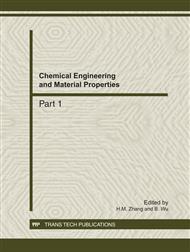p.580
p.585
p.590
p.595
p.600
p.606
p.611
p.615
p.620
Influence of Rubber Crumb Addition to Portland Cement Concrete
Abstract:
In this paper, two kinds of rubber surface modifying methods were studied. One was bis[3-(triethoxysilyl) propyl] tetrasulfide (Si-69) silicon alkane coupling agent and the other was crylic acid coupling agent. The mechanical properties of cement concrete with modified rubber crumb and with non-modified rubber crumb were tested respectively. The results show that as the rubber crumb addition rises, the toughness of concrete with non-modified rubber crumb increases while the compressive strength decreases, and both thoughness and compressive strength of cement concrete with modified rubber crumb increase. The chloride impermeability of the rubber concrete are much better than that of the Portland cement concrete. After surface modification the chloride impermeability can be improved more. The thermoanalysis proves that the surface of modified rubber crumb is grafted by polar function groups, so the surface changes from hydrophobic to hydrophilic. The scanning electron microscopy (SEM) analysis confirms that the interface between rubber crumb and cement matrix is improved.
Info:
Periodical:
Pages:
600-605
Citation:
Online since:
December 2011
Authors:
Keywords:
Price:
Сopyright:
© 2012 Trans Tech Publications Ltd. All Rights Reserved
Share:
Citation:


